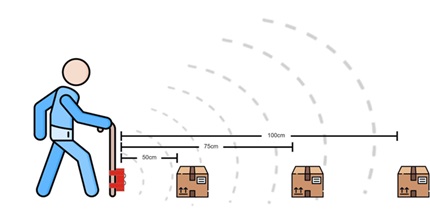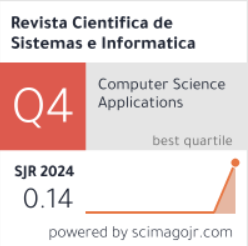Inclusive innovation: Implementation of low-cost proximity sensors for canes
DOI:
https://doi.org/10.51252/rcsi.v5i1.838Keywords:
autonomy, accessibility, ultrasonic, IoT, microcontrollersAbstract
Visually impaired individuals face challenges in moving safely, affecting their independence and increasing the risk of accidents. This work presents the development of a prototype accessory for canes with ultrasonic sensors, designed to enhance mobility and independence at a low cost. The device, based on IoT, uses an Arduino Nano, an HC-SR04 ultrasonic sensor, and a buzzer, generating progressive acoustic alerts based on obstacle proximity. During testing, it demonstrated high effectiveness in detecting large objects and issuing immediate alerts; however, it showed limitations with small objects, liquids, and humid environments. The need to optimize the battery, which is currently replaceable, was identified, and as a future improvement, the incorporation of wireless charging technologies and LIDAR sensors was proposed for more precise detection. Additionally, it was recommended to include a night LED to alert others and improve the cane's materials for greater durability. The prototype's design is lightweight, accessible, and functional, prioritizing simplicity without compromising reliability. Compared to similar devices, it stands out for its effectiveness and low cost, offering a viable solution to improve the mobility and independence of visually impaired individuals, reducing risks and facilitating social integration.
Downloads
References
Bansal, M., Malik, S., Kumar, M., & Meena, N. (2020). Arduino based Smart Walking Cane for Visually Impaired People. 2020 Fourth International Conference on Inventive Systems and Control (ICISC), 462–465. https://doi.org/10.1109/ICISC47916.2020.9171209
Choe, S., Cha, S.-Y., Cheon, D., Kwak, S.-B., & Kim, H.-S. (2023). Smart Cane Using Time-Division Overlapped-Beam Based Multi-Ultrasonic Sensors. The Journal of Korean Institute of Communications and Information Sciences, 48(9), 1091–1101. DBpia. https://doi.org/10.7840/kics.2023.48.9.1091
Díaz Alva, A. (2023). Bastón inteligente: Innovación inclusiva. Willachikuy, 3(2), 3–4. https://doi.org/10.46363/willachikuy.v3i2.2
Gharghan, S. K., Kamel, H. S., Marir, A. A., & Saleh, L. A. (2024). Smart Stick Navigation System for Visually Impaired Based on Machine Learning Algorithms Using Sensors Data. Journal of Sensor and Actuator Networks, 13(4). https://doi.org/10.3390/jsan13040043
Harini, A., Buvana, C., Harshini, M., Keerthana, S., Prabhu, D., & Umamaheswaran, S. K. (2024). Iot Based Smart Assistant Cane For The Visually Impaired. 2024 International Conference on Communication, Computing and Internet of Things (IC3IoT), 1–6. https://doi.org/10.1109/IC3IoT60841.2024.10550222
Jang, D.-K., Yang, D., Jang, D.-Y., Choi, B., Lee, S.-H., & Shin, D. (2024). ELMO: Enhanced Real-time LiDAR Motion Capture through Upsampling. ACM Transactions on Graphics, 43(6). https://doi.org/10.1145/3687991
Leporini, B., Raucci, M., Rosellini, M., & Forgione, N. (2023). Towards a Haptic-based Virtual Cane to Assist Blind People in Obstacle Detection. Proceedings of the 16th International Conference on PErvasive Technologies Related to Assistive Environments, 10–13. https://doi.org/10.1145/3594806.3594864
Ma, Z., Wang, S., Ma, Z., Li, J., Zhao, L., Li, Z., Wang, S., Shuang, Y., Wang, J., Wang, F., Xia, W., Jian, J., He, Y., Wang, J., Guo, P., & Wang, H. (2024). Efficient and Stable Photoassisted Lithium-Ion Battery Enabled by Photocathode with Synergistically Boosted Carriers Dynamics. Nano-Micro Letters, 17(1), 74. https://doi.org/10.1007/s40820-024-01570-7
Mai, C., Chen, H., Zeng, L., Li, Z., Liu, G., Qiao, Z., Qu, Y., Li, L., & Li, L. (2024). A Smart Cane Based on 2D LiDAR and RGB-D Camera Sensor-Realizing Navigation and Obstacle Recognition. Sensors, 24(3). https://doi.org/10.3390/s24030870
Minatani, K. (2024). Proposal for a Versatile Smart White Cane Infrastructure Using a 3D Printer: As a R&D Platform and a Practical Product Design. Proceedings of the 17th International Conference on PErvasive Technologies Related to Assistive Environments, 21–26. https://doi.org/10.1145/3652037.3652064
Mocanu, A., Sita, V., Avram, C., & Aştilean, A. (2024). Enhanced Cane for Blind People Mobility Assistance. 2024 IEEE International Conference on Automation, Quality and Testing, Robotics (AQTR), 1–6. https://doi.org/10.1109/AQTR61889.2024.10554132
Muktha., D. S., Niveditha, G., Pinto, N. A., & Sinha, S. (2024). Enhancing Mobility: A Smart Cane with Integrated Navigation System and Voice-Assisted Guidance for the Visually Impaired. 2024 IEEE 13th International Conference on Communication Systems and Network Technologies (CSNT), 1124–1129. https://doi.org/10.1109/CSNT60213.2024.10546111
Nazri, N. M. A., Fauzi, S. S. M., Gining, R. A. J., Razak, T. R., & Jamaluddin, M. N. F. (2020). Smart Cane for Visually Impaired with Obstacle, Water Detection and GPS. International Journal of Computing and Digital Systems. https://api.semanticscholar.org/CorpusID:222078779
Panazan, C.-E., & Dulf, E.-H. (2024). Intelligent Cane for Assisting the Visually Impaired. Technologies, 12(6). https://doi.org/10.3390/technologies12060075
Paredes Orozco, D. L., & Domínguez-Morales, M. (2024). Smart Cane for the Visually Impaired. In Y. Torres, A. M. Beltran, M. Felix, E. Peralta, & D. F. Larios (Eds.), Recent Advances and Emerging Challenges in STEM (pp. 451–460). Springer Nature Switzerland.
Remya, V., Subramani, S., Gokulnaath, M., Sibiraj, T., Priyan, T., & Rajalakshmi, S. (2023). Smart Walking Cane for Navigation of Visually Impaired. 2023 Intelligent Computing and Control for Engineering and Business Systems (ICCEBS), 1–4. https://doi.org/10.1109/ICCEBS58601.2023.10448603
Romeo, N. K., Rajbanshi, S., Lukama, W., Kaur, M., Rakesh, N., & Goyal, M. K. (2022). Design a Smart Cane for Visually Impaired Individuals’ Assistance. 2022 International Conference on Fourth Industrial Revolution Based Technology and Practices (ICFIRTP), 295–296. https://doi.org/10.1109/ICFIRTP56122.2022.10063212
Song, H., Panda, S., Hajra, S., Hwang, S., Jo, J., Kim, N., Panigrahi, B. K., Yu, J., Jeong, S. M., & Kim, H. J. (2024). A Self-Powered Smart White Cane for Improving Mobility of Visually Impaired Person Using a Triboelectric Nanogenerator. Energy Technology, 12(7), 2400424. https://doi.org/10.1002/ente.202400424
Trujillo Mora, V., González Jaimes, E. I., López Chau, A., & Bautista López, J. (2021). Analysis of the usefulness of the UAEM Smart White Cane for people with visual impairment. RIDE. Revista Iberoamericana Para La Investigación y El Desarrollo Educativo, 11(22). https://doi.org/10.23913/ride.v11i22.897
Ulfa, A., Rosspertiwi, A. A., Sahroni, A., & Murnani, S. (2023). S-Cane: Ultrasonic Sensor-Based Smart Cane for the Visually Impaired. 2023 IEEE International Biomedical Instrumentation and Technology Conference (IBITeC), 7–11. https://doi.org/10.1109/IBITeC59006.2023.10390939
Venkatraman, S., Subramanian, K., Tolia, C., & Shanbhag, R. (2020). Smart Cane-An Aid for the Visually Challenged. In J. S. Raj, A. Bashar, & S. R. J. Ramson (Eds.), Innovative Data Communication Technologies and Application (pp. 692–701). Springer International Publishing.
Vineeth, I., Sharan, Y. H. V. S., Karthik, Y., & Priya, B. K. (2021). Smart Cane for Visually Impaired Person. 2021 International Conference on Intelligent Technologies (CONIT), 1–6. https://doi.org/10.1109/CONIT51480.2021.9498563
Yam, B., & Elshakankiri, M. (2024). The Design of Smart Cane SC+. In A. K. Nagar, D. S. Jat, D. Mishra, & A. Joshi (Eds.), Intelligent Sustainable Systems (pp. 461–470). Springer Nature Singapore.
Yauri, R., Alvarez, K., Cotaquispe, J., Ynquilla, J., & Llerena, O. (2024). Guidance device for visually impaired people based on ultrasonic signals and open hardware. International Journal of Reconfigurable and Embedded Systems, 13(3), 520–527. https://doi.org/10.11591/ijres.v13.i3.pp520-527
Zaidi, S. F. N., Shukla, V. K., Gupta, S., & Preetha, V. K. (2023). Enhancing Access of the Visually Impaired Through the Smart Cane. In S. Vyas, A. Upadhyaya, D. Bhargava, & V. K. Shukla (Eds.), Edge-AI in Healthcare: Trends and Future Perspectives (pp. 65–78). CRC Press. https://doi.org/10.1201/9781003244592-5

Downloads
Published
How to Cite
Issue
Section
License
Copyright (c) 2025 Herald Gonzales-Saavedra, Kenjy Garcia-Hurtado, Carlos Gallegos-Pinedo, Rodrigo Tenazoa-Bardales, Anthony Ordinola-Sinarahua, Diego Hilario-Putpaña, Dick Diaz-Delgado

This work is licensed under a Creative Commons Attribution 4.0 International License.
The authors retain their rights:
a. The authors retain their trademark and patent rights, as well as any process or procedure described in the article.
b. The authors retain the right to share, copy, distribute, execute and publicly communicate the article published in the Revista Científica de Sistemas e Informática (RCSI) (for example, place it in an institutional repository or publish it in a book), with an acknowledgment of its initial publication in the RCSI.
c. Authors retain the right to make a subsequent publication of their work, to use the article or any part of it (for example: a compilation of their works, notes for conferences, thesis, or for a book), provided that they indicate the source of publication (authors of the work, journal, volume, number and date).









